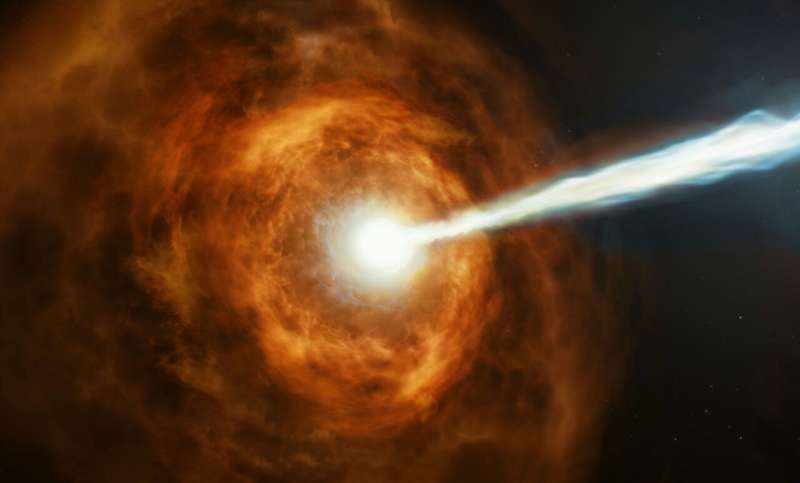
August 30, 2024 by David Appell , Phys.org
Collected at: https://phys.org/news/2024-08-gamma-ray-violations-einstein-postulates.html
Einstein’s theory of relativity is based on two assumptions, or postulates. The first is that the laws of physics look the same to everyone traveling in a straight line with no acceleration.
Einstein took this idea from the Dutch physicist Hendrik Lorentz, who, in the late 1800s, presented a theory of electrodynamics with this property, giving rise to the notion of an “inertial frame of reference”—the coordinates used by a butcher, baker or candlestick maker when they move in a straight line in a vacuum, relative to one another, possibly with different velocities. This assumed equivalency is called “Lorentz invariance.”
The second assumption is that the speed of light will be measured as the same by anyone in an inertial reference frame. No matter how fast one is moving or in what direction (in a vacuum), light will be seen approaching at a speed of “c,” just under 300,000 kilometers per second, with the same speed seen if it passes by. Even if the baker is moving at 0.99999 percent of the speed of light relative to the butcher, both measure light to have a speed of “c.” (Yes, that’s not at all intuitive.)
Physicists have been keen to test Lorentz invariance ever since. It strictly holds in all experiments done to date. Now, a group from China has looked at the most powerful gamma ray burst ever seen and found that the photons it emitted at the same time arrived at their telescope at the same time, even if they had different frequencies.
From this result, the lower energy limit where quantum gravity appears has been raised five-fold. Their work has been published in the journal Physical Review Letters.
Interest in Lorentz invariance has picked up in recent years as some theories of quantum gravity predict that for high-energy photons, the vacuum does not appear empty but as a nonempty medium. This prediction, when it occurs in a quantum gravity theory, occurs near the Planck scale of about 1019 billion electron-volts, where it is expected that spacetime itself might need to be treated according to the rules of quantum mechanics.
Does Lorentz invariance hold even at such enormous energies, or do the laws of physics start to look different there for different inertial reference frames?
To test this, a research group from the Large High Altitude Air Shower Observatory (LHAASO) in China looked at the afterglow of the brightest gamma-ray burst ever observed, 221009A. This GRB, discovered in 2022 and lasting just over 10 seconds, but observable for 10 hours after detection, was in a distant galaxy 2.4 billion light-years away, meaning its highly energetic gamma rays had taken 2.4 billion years to arrive at Earth.
A violation of Lorentz invariance would appear if the light of different frequencies arrived at Earth at different times, meaning they had different speeds when traveling through the long vacuum from there to here. This phenomenon is called “photon dispersion,” and it’s seen when light travels through materials like water or glass, but so far, it has never been detected in a vacuum.
The research team used data collected from the October 9, 2022 gamma-ray burst recorded at the Observatory in Sichuan, China, 4,410 meters above sea level. Gamma-ray observatories in orbit were first triggered by the initial lower energy photons, and LHAASO happened to be pointed in the right direction to measure the burst’s “afterglow” of high-energy photons.
Within 100 minutes after the 221009A trigger, their Water Cherenkov Detector Array measured more than 64,000 photons with energies up to 7 trillion electron-volts. Over its short lifetime, the GRB was estimated to release as much energy as the entire Milky Way galaxy does in 500 million years.
The peak intensity from the GRB occurred about four minutes after its trigger. To examine any signs of a violation of Lorentz invariance, the group used two methods: measuring the time delays between 10 gamma-ray energy bands, with each band containing TeV-scale photons, and extracting energy-dependent arrival-time delays from the data.
Their analysis found no statistically significant violations of Lorentz invariance—no significant time delays of the GRB photons with different frequencies. (By the Planck relation, frequency is proportional to energy.)
From this lack of photon dispersion, they obtained two lower limits on the energy where quantum gravity effects might appear, one the same as seen in previous GRB observations, and the second raising the previous lower limit by a factor of five for inertial reference frames traveling below the speed of light.
They conclude, “Future observations of very high energy prompt [quick] emission instead of afterglow from GRBs would further enhance sensitivity to Lorentz invariance using time-of-flight tests.” These limits could be raised even higher if the initial stage of a future GRB is similarly examined.
More information: Zhen Cao et al, Stringent Tests of Lorentz Invariance Violation from LHAASO Observations of GRB 221009A, Physical Review Letters (2024). DOI: 10.1103/PhysRevLett.133.071501. On arXiv: DOI: 10.48550/arxiv.2402.06009
Journal information: Physical Review Letters , arXiv

Leave a Reply